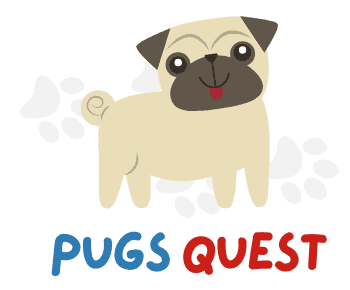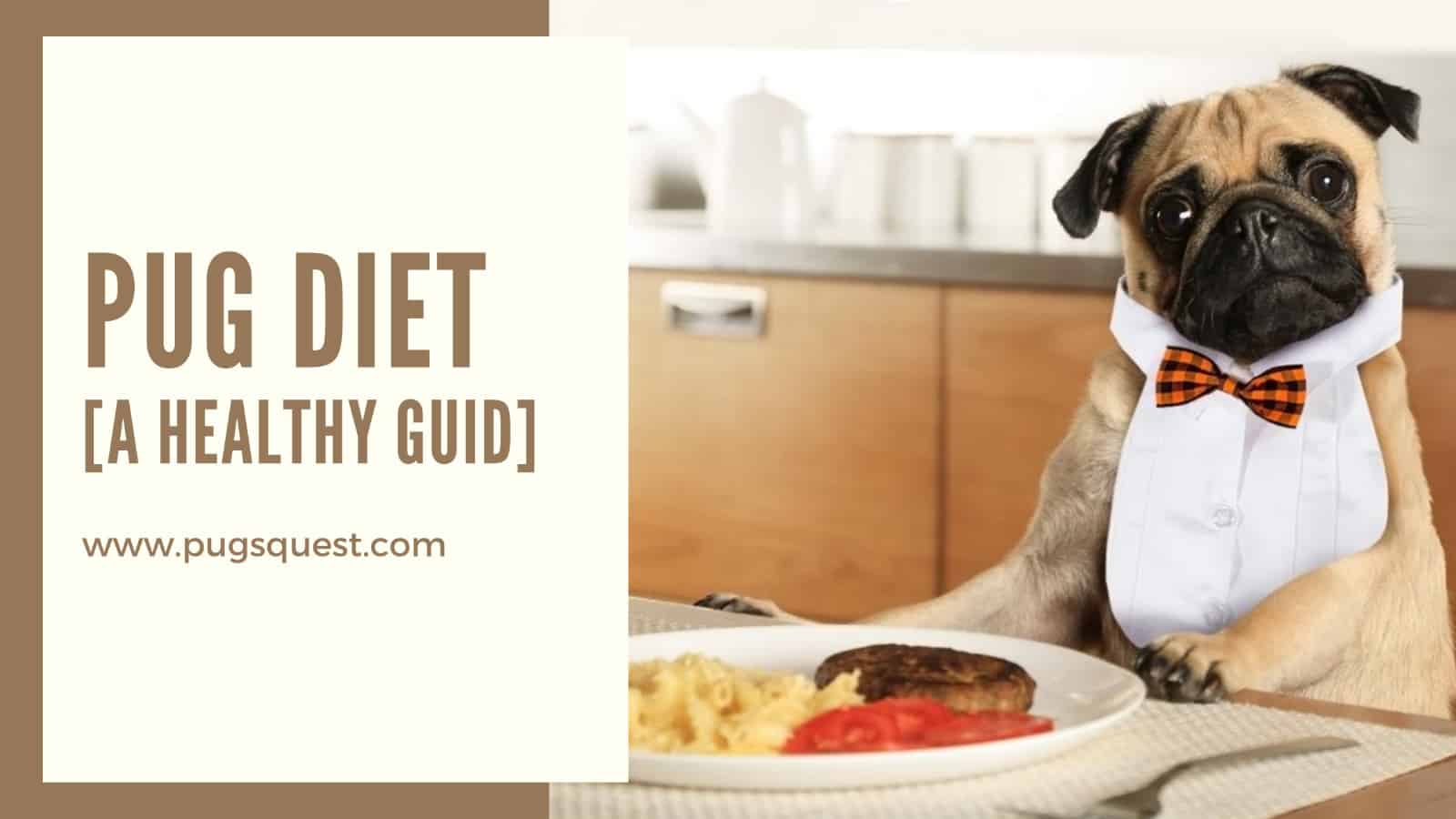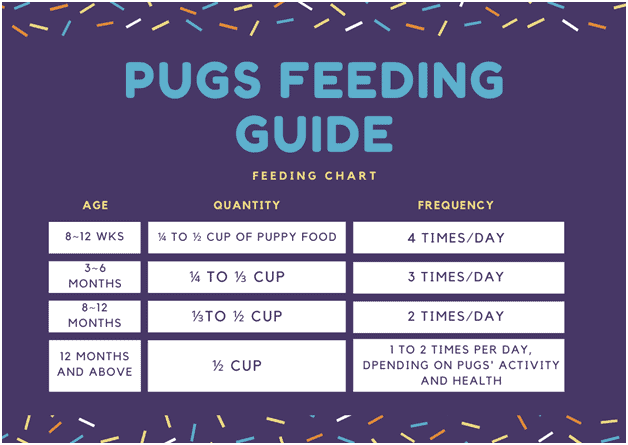*This post contains affiliate links, and we will be compensated if you buy after clicking on our links.
Pugs will probably tell you that they need to help you eat your cheeseburger, but don’t listen to those pleading eyes.
Because pugs can have a wide range of dietary sensitivities, it’s crucial to know what to keep away from them and what to add to their diets.
In order to find the best diet for Pugs, I wanted to expand on how to keep your pug their healthiest – nutritionally speaking—so they can have a long, ailment-free life.
Pug Diet: Key Takeaways
1. If you opt for dry kibble, keep an eye on the label. Get the fewest ingredients possible, and say no to fillers, animal byproducts, and synthetic ingredients.
2. Wet food is excellent in terms of nutrition, but offers frequent teeth cleaning so your pug doesn’t get plaque buildup and develop tartar.
3. Homemade food may be a little more time consuming to make, but you have full control over the ingredients. It may be the best option if your pug is sensitive to specific ingredients or has known allergies.
4. Pugs are prone to obesity, so portioning food correctly is vital to their overall well-being.
5. Human food is never a proper meal or snack, and you should never allow your pug to have leftovers or treats while you eat.
What is the Best Diet to Feed Your Pug?
The most important part of a well-balanced, nutrition-rich diet is knowing precisely what you’re putting in their food bowl.
Commercial food can have ingredients on the label that you can’t pronounce, including additives that are not healthy for your pug in the slightest.
I give Sid a combination diet of wet and dry store-bought dog food.
I add in treats for him like raw carrots, cucumber, and berries.
He also enjoys a little bit of cooked egg from time to time.
Giving your pug kibble shouldn’t be the only nutrition you offer them.
You can spice things up by alternating snacks, so they get a full benefit of nutritional content in various forms.
1. Home-Cooked Meals
Preparing food at home can prove to be a bit more time-consuming, but you will have full control over every ingredient.
When you make food at home, you want to add an excellent selection of fresh fruit, vegetables, protein, and rice.
If you make a large batch of food, you can freeze or refrigerate it so you can store it.
Refrigerated dog food can last up to four days, and frozen food can last up to three months.
2. Store-Bought Food
When it comes to store-bought food, you generally have to choose between dry kibble, wet canned food, or fresh food.
Since this diet is pre-made, you need to pay close attention to the label, especially if you have a pug with known food sensitivities.
Many well-known brands that you see in stores have unnecessary fillers, animal by-products, chemicals, and unhealthy dyes.
These ingredients can spark a whirlwind of physical symptoms for your pug and can even sometimes cause fatalities.
3. Dry Kibble
Dry kibble has many health benefits for your pug.
It’s probably the most common choice among pet owners for convenience and shelf-life.
It has perks and can be an extremely healthy choice for your pug if you buy the right types.
[su_spacer]
- √Shelf-life of up to 12-18 months (unopened)
- √Reduces plaque buildup and tartar
- √Generally cheaper than canned food
- √Less messy
- √Very convenient to dish out
- ⊗Can have many fillers
- ⊗Provides no moisture
- ⊗Needs preservatives
- ⊗Higher carb content
4. Wet Canned Food
Wet canned food is a fabulous choice for pugs, and is generally more palpable for them.
This is definitely Sid’s preference, and even though it is usually more expensive, it evens out a bit.
Because of pugs being so small, they don’t require large rations.
[su_spacer]
- √More protein
- √Wider flavor variety
- √Easy to digest
- √Less carb content
- √No synthetic preservatives
- √Provides hydration
- ⊗More expensive
- ⊗Does not clean teeth
- ⊗May contribute to periodontal disease
Pro Tip:
Pugs might require different supplements including vitamin, mineral, skin and joint health supplements, etc. Consult your vet to get the best fit is always the best idea.
If you are looking for vitamin supplements for Pugs, I found Pet MD’s Advanced Multivitamins works great for Pugs.
Whether to give your Pugs a chewable treat or mixed them into food, they taste good, your Pugs will like them.
How Much Should You Feed Your Pug?
Feeding your Pugs the right amount of food leads to better health, understanding the calories for proper growth plays an important role in healthy feeding.
The amount you feed your pug will depend on their stage of life and current weight.
If you buy store-bought food, you can read the serving chart on the back to figure out how many cups you should feed them at their current state.
Each bag may have slightly different measurements, so always be sure to check the labels for exact instructions.
- Puppies
Pug Puppies require a well-rounded diet with all of the essential vitamins, minerals, and proteins necessary for proper development.
Being in a growth phase requires added boosts of caloric intake.
A general rule of thumb is that you should feed your pug puppy 50 calories per pound of body weight.
- Adults
Adult pugs need a stabilized diet that is consistent in nutritional content and calories.
It can vary depending on whether your pug is at a healthy weight.
For an average pug which requires 40 calories per pound, they will need around ½ cup of quality dog food twice a day.
- Seniors
Senior pugs are slowing up, and they require a slightly different diet.
You will want to be sure that you still feed them around ½ cup one or twice a day (depending on weight), but their bodies need high levels of nutrition to make up for the natural bodily decline.
Tip: Always make sure your pug has a bowl of fresh, clean water available to them.
How Often Should You Feed Your Pug?
What I like to do with Sid is break up his rations twice a day. Sid, for instance, is a 15-pound adult pug.
I feed him ½ cup twice daily—once in the morning, once in the afternoon. I like to do it that way, so he doesn’t have such long spans between meals.
However, it isn’t unhealthy to feed an adult pug one full meal per day.
I would recommend offering healthy treats in the evening if you don’t plan to split up the feeding.
Allowing them to have an empty stomach can cause them to vomit bile, which is an acid in the stomach.
Pugs can even have a meal three times a day, but be careful when you measure since this can lead to overfeeding.
This is typically fine for puppies since they require so much nutrition as they grow.
But I have found switching to twice a day and offering a midday treat works excellent for adult pugs.
Best Diet for Pugs: Recommended List
If you decide to buy your pug a store-bought food type for the main diet source, here are the three best products I can recommend for puppies, adult pug, and obese pugs.
1.Best for Puppies: Nutro Wholesome Essentials Puppy

This particular type is chicken flavored with brown rice and sweet potato.
Chicken is the number one ingredient, so it is a great protein with 27.0% crude protein.
The food is non-GMO, free of animal byproducts and artificial additives.
It has extra calcium to help support bone growth and healthy omega fatty acids.
There are many added vitamins and minerals to keep your puppy on a healthy track as they develop.
It has only the essential ingredients without the use of fillers or other additives that don’t benefit the body.
As with many other sensitivities, you may notice your pug developing allergies.
If so, you may want to change protein sources since some dogs have an issue with chicken.
[su_spacer]
- √Non-GMO
- √Chicken is a #1 ingredient
- √Added vitamins and minerals
- √No artificial additives
- ⊗Pug could be sensitive to chicken protein
2. Best for Adult Pugs: Blue Buffalo Homestyle Recipe
Blue Buffalo Homestyle Recipe has my vote for the best dog food for adult pugs.
Sid hears me pop open the can and comes running with anticipation.
He loves the way it tastes, and I can barely get it into the bowl before it’s gone.
I also like offering dry kibble in addition to the wet food to help break things up and give him a substantial variety.
That helps him digest the food and not readjust to a new type of food—no stomach upsets.
This food has less carb content than the kibble, which is great for weight management.
And while it is somewhat more expensive, it lasts quite a while, and I know that it is perfectly healthy for him.
It gives him a well-balanced diet full of natural chicken as the number one ingredient.
Plus, it has no wheat, soy, corn, or animal byproducts, so I know he isn’t getting a bunch of potentially allergy-triggering additives.
There are no preservatives or artificial ingredients, which helps me rest easy knowing I’m reducing the chances of medical issues in the future.
There are twelve cans total, which stretch quite nicely.
I also love to feed it to him as a solo meal or as a delicious topper.
[su_spacer]
- √No corn, wheat, or soy
- √Chicken is #1 ingredient
- √Extra hydration in diet
- √Tasty and aromatic
- ⊗More expensive than kibble
3. Best Food for Obese Pugs: Purina Pro Plan Weight Control

The entire formula is for dogs who need to gain more control over their caloric intake by cutting carbs and calories in half while giving your pug proper nutrition.
I love that this dog food has live probiotics and prebiotics, which aid in proper digestion and help your pug’s gut flora thrive.
This is a crucial factor when it comes to correctly flush the system.
Another great quality is that there are actually dehydrated chicken shreds in the food, so the flavor is more appealing.
There is 25% less fat, but a solid 26.0% prude protein—which helps keep muscles secure while promoting weight loss.
Even though this works well for helping your dog shed the pounds, it may not suit every pug.
It has a few triggers in the food that can irritate allergies like wheat and gluten.
[su_spacer]
- √Prebiotics and probiotics
- √High protein, low carb
- √Dehydrated chicken shreds
- ⊗Not for allergy-prone pugs
FAQs
1. What Food is Bad for Pugs?
There are a few things to steer clear of while creating a solid diet for your pug:
- Foods that contain meat byproducts
- Corn, wheat, or soy fillers
- Certain grains that were treated with chemicals before harvest
- Preservatives, dyes, and artificial ingredients
- BHA, BHT, and ethoxyquin
- Rendered fat
- Corn syrup
- MSG and xylitol
- Onions, garlic, grapes, raisins, and chocolate
2. Is Egg Good for Pugs?
An egg is a very nutritional treat for your pug.
You can add it to a food dish or homemade meal.
It’s an excellent protein supplement, especially digestible, if you have a pug who is sensitive to other common meat protein, such as chicken or beef.
Egg has other excellent essential amino acids and omega-3 fatty acids.
They make a delightful treat and can calm upset stomachs in sensitive pugs.
Do be mindful not to give your pug raw or undercooked eggs, however.
Salmonella and other bacteria can make your pug very sick.
Conclusion
Diet is one of the most essential aspects to nurture to give your pug a long life. A poor diet for Pugs can result in health issues and shorter lifespans.
Hopefully, this post gave you some great tips on how to feed your pug best so they can have a healthy, happy existence.



